|
Peripheral or rollout photography
of edge markings on three US medals This was a project where there was text engraved or otherwise impressed into the edge of three medals and it was desired to make the text visible as a flat, continuous, reproduction. This can be accomplished by making a peripheral or rollout record of the edge by placing the medals on a turntable and recording the text as it passes over the slit of a film type strip camera or a linear array in a digital strip camera. The following information was given or measured off the individual medals and determinations of operating parameters for a film type strip camera that moves film past a narrow slit by rewinding the film through the camera with the shutter locked open. As the film moves behind the slit the image of the surface of the medal moves above it. For a good reproduction of the text on the edge of the medals the film speed behind the slit should match the rate the image moves above it. For a digital record the aspect ratio of the medal should be maintained in the reproduction. FILM BASED STRIP CAMERA SOLUTION
Using an incident meter determine the aperture required with the given film speed and lighting level for the above exposure times. If operating at larger than life size magnification it is possible to simply lengthen the time it takes the turntable to make the time for one revolution proportional to the increase in magnification over life size. So at 2 times life size one can simply make the turntable make a full rotation in 60 seconds rather than 30. Everything else remains the same. The medal circumferences will then be twice as long (and high!) as their life sized versions. To find magnification simply divide the height of the medal into the height of the image of the edge of the medal. Make sure to take the lens cap off the lens prior to photography!. Also make sure to push up on the rewind release button and that the shutter is in the locked open position using the locking cable release. Under the conditions currently set up in the lab an aperture of about f/11 with 100 speed film seems to be OK with film being moved at about 8 mm per second. At 4 mm per second it would be f/16. When metering remember that the semi-silvered mirror in the camera absorbs about a stop of film speed. Using color negative film slight overexposure is better than underexposure. The set-up for the film strip camera looked like shown in the photographs below. 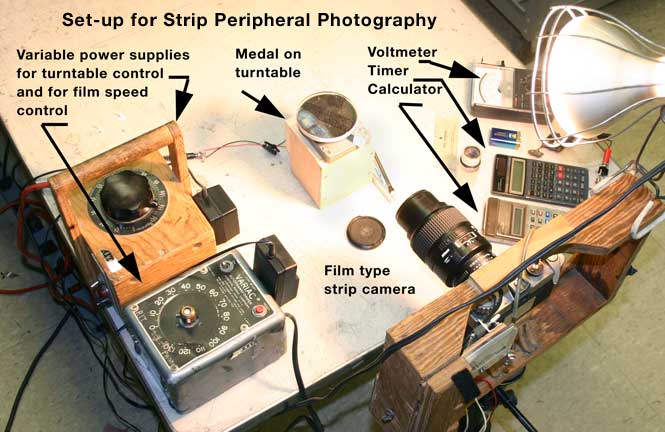 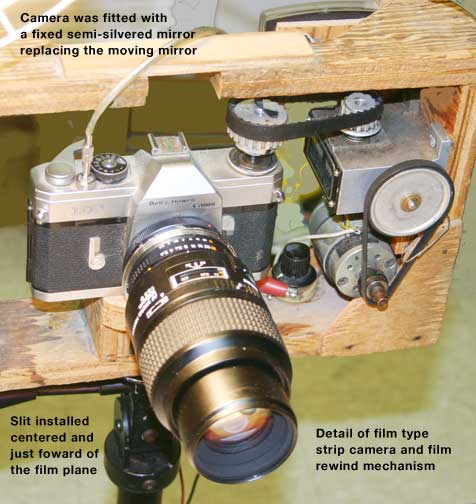 The results of the film strip peripheral records when they become availble will be included here as they become available. DIGITAL SOLUTION WITH LINEAR ARRAY In the case of a digital linear array system once the camera is set-up at some desired working magnification one needs to adjust the rotation rate of the turntable or the scanning rate of the scanner so that the aspect ratio in the recorded image of the medal's edge to circumference is maintained. A reasonable amount of error can be often successfully adjusted with such digital image files by unconstraining the aspect ratio of the height to width of the image and making the image of the record acquire the desired aspect ratio. This is quite impossible to do with film records as a mismatch in film/image speeds invariably leads to loss of sharpness which can't be corrected later. In this case the aspect ratio of the medals was: 1) 7.0 mm to 240 mm or 1 : 35 2) 4.0 mm to 242 mm or 1 : 60 3) 3.5 mm to 123 mm or 1 : 35 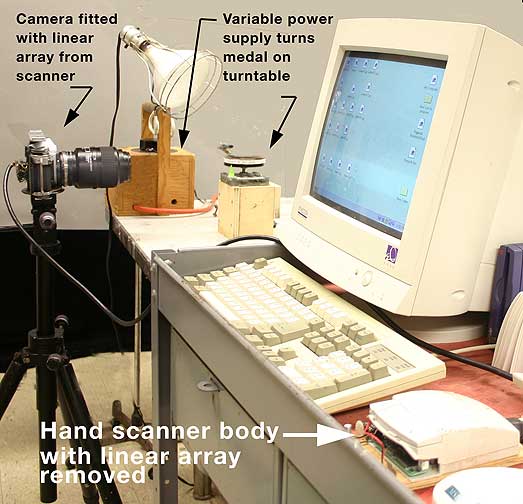 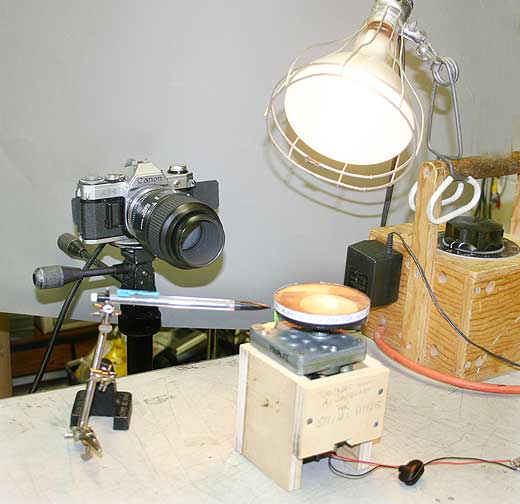
The immediacy of the digital records indicated that I failed to account for the fact that the medals would not lie flat but that their surface relief would cause them to be not level which would produce a slightly wavy result as far as the location of the edge within the record. Additionally, the medals were placed on a soft surface and the "fuzz" of that material in one case in particular extended above the edge of the medal. This would have had to corrected when it would become visible in the film record but that would have meant a rephotography session which the digital technique made unnecessary. The results of the digital scanning process are shown in the illustration below. A similar set of results will be produced for the film records once the processing and scanning of the negatives is completed. This may take some time so please don't wait standing! 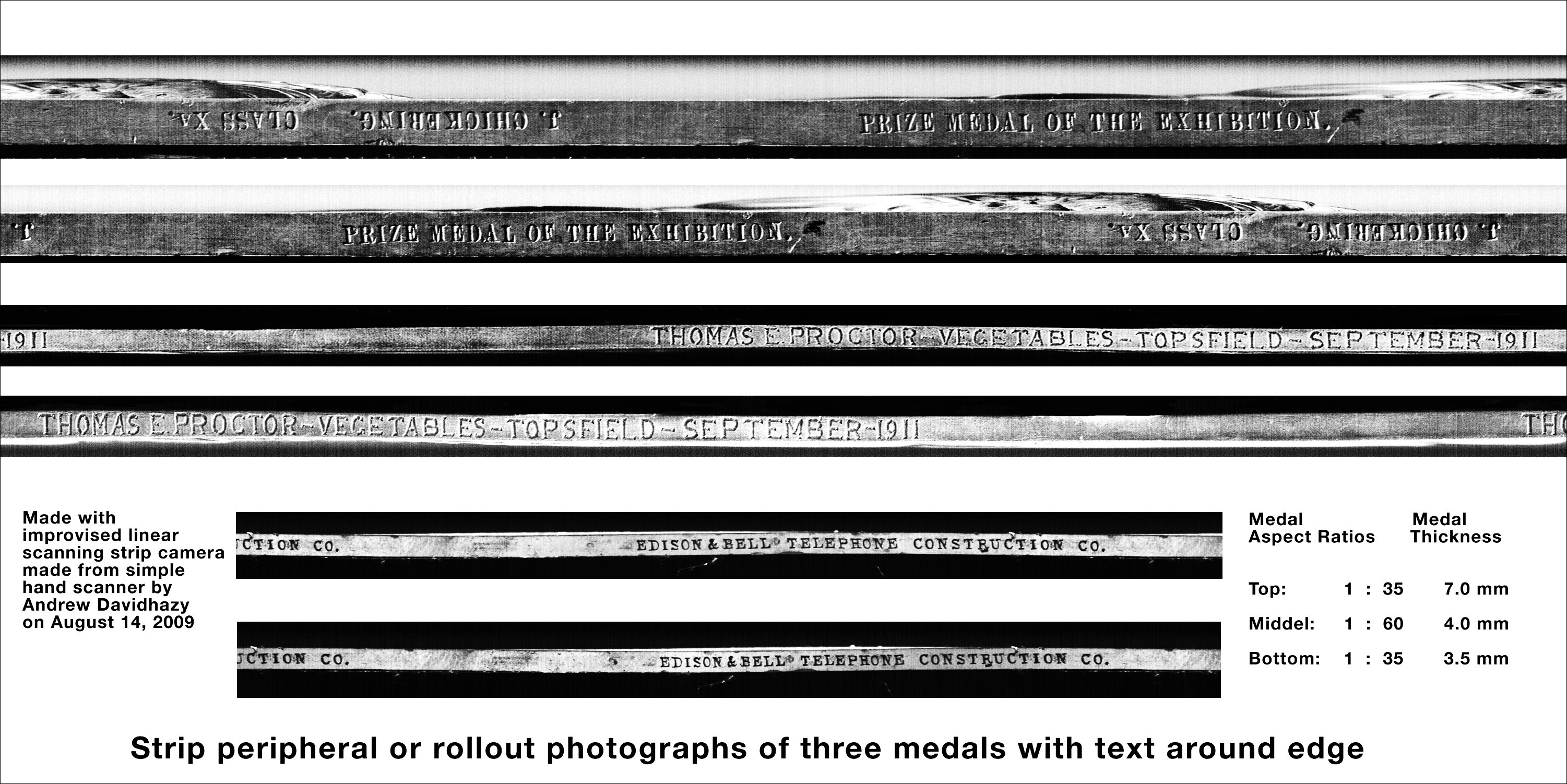 If you have any questions or comments to make about this project or if you also have coins or medals or other similar objects of which you'd like to have peripheral or rollout photographs made drop me a line and we will arrange something. My consulting fees are not exorbitant ... as long as it does not become a chore. If your interest raises a challenge for me and smacks of an entertaining and informative pastime I am ready to help! Andrew Davidhazy andpph@rit. edu |